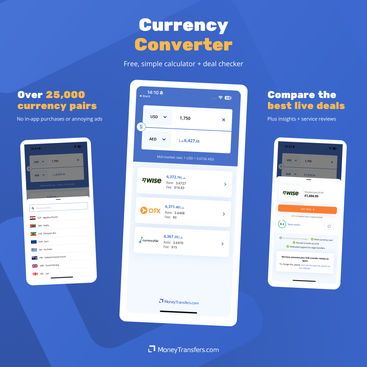USD to EUR Forecast - December 2025
In simple terms, the U.S. dollar is weakening, and the euro is getting stronger
Over the past few months, the euro has strengthened against the U.S. dollar.
Right now, $1 only gets you around €0.85328 (with EUR/USD trading near 1.17), the euro is near its strongest point in over four years.
This means it now takes more dollars to buy the same amount of euros.
If you're sending money from the U.S. to Europe (for example, Spain), it's currently more expensive than earlier this year. You’ll get fewer euros for each dollar.
Search Now & Save On Your Transfer
What is likely to happen to USD/EUR in December 2025
The euro is slightly favored for the next month thanks to softer US data and improving eurozone conditions. Watch the 1.1650 to 1.17 zone for clues on direction. If the euro breaks higher, expect a move toward 1.18. If it fails, the pair may return toward 1.15. For anyone sending USD to EUR, costs may edge higher, so timing matters.
USD to EUR: Where It Stands
The USD to EUR rate has been moving higher in the euro’s favor, rising from around 1.15 toward the 1.16 to 1.17 area. The euro has strengthened thanks to better eurozone data and expectations that the US Federal Reserve will continue to cut interest rates. For now, the pair is stuck in a broad range between 1.15 and 1.18.
What’s Driving USD to EUR?
Here are the main forces behind the recent moves.
The US economy is showing signs of softness, including weaker labor data and government shutdown worries. This makes the dollar less attractive.
The Federal Reserve is expected to keep cutting interest rates into 2026. Lower US rates usually weaken the dollar.
The European Central Bank is sounding more confident about growth. A stronger eurozone outlook supports the euro.
Lower energy costs and improved eurozone data make the euro more appealing.
Market expectations for a more dovish future Fed Chair also put downward pressure on the dollar.
What Do the Charts Say?
The key zone to watch is 1.1650 to 1.17. This is a major resistance area. If the euro moves above it, the next target is around 1.18. If it fails to break through, the pair could slip back toward 1.15. Overall, the pair remains in a rising channel, but momentum has recently slowed. Traders are watching support at 1.1607 and 1.1578. A break below these could open the door toward 1.1550 to 1.1450.
What to Watch in December 2025
Here are the events most likely to move the USD and EUR soon.
The next Federal Reserve meeting. If the Fed sounds less dovish about 2026, the dollar could bounce.
US labor data. Weak numbers favor the euro. Strong data could pull the pair lower.
Any announcement about the next Fed Chair. A dovish candidate keeps the dollar soft.
Eurozone economic updates, especially on growth and retail sales. Strong eurozone data supports the euro.
Overall market sentiment. Risk-off driven by economic worries usually helps the dollar. Risk-off caused by US political concerns tends to weaken the dollar.
Risks Ahead
Here are the main things that could change the outlook quickly.
A sudden rebound in US economic data could strengthen the dollar.
If the eurozone recovery slows or data disappoints, the euro may lose momentum.
Big volatility around major US tech earnings or US political events could create sharp short-term moves.
Any surprise from the ECB or the Fed on interest rates.
What This Means If You’re Sending USD to EUR Abroad
The euro has been gaining ground, so converting USD to EUR is becoming a bit more expensive. If the euro climbs above 1.17, the cost to send euros from USD could increase further. But if the rate drops back toward 1.15, sending euros becomes cheaper. Because the market is in a wide range, small swings are likely. If you need certainty, you may consider sending part now and part later to average out the rate.
Live USD to EUR exchange rates
Converting USD to EUR
If you are planning to send USD to EUR, you need to pick the right money transfer company to get the most EUR on the other end.
Depending on your needs, it's best to use one of the following companies in December:




History of the USD to EUR
Europe and the United States always had close economic and social ties which were done using the US dollar and local currencies for a long time.
Germany had Deutsche Mark while France had the franc and Italy had the lira, all these changed on January 1999 when the European Union introduced using a common currency known as the euro.
The euro currency was then officially launched on January 1, 2002. 20 of the 27 EU member countries use the euro.
In most cases, the USD and euro exchange rate is identified as per the ISO standard- EUR/USD.
Over the years, the performance of the pair has favored the US dollar because of the overall strength of the American economy and the fact that the dollar is the reserve currency of the world.
In 2022, the EUR/USD price crashed below the parity level for the first time in two decades.
The USD to EUR is the most liquid currency pair internationally because of the volume of trade between the US and Europe.
Euro is often seen as a safe currency, which makes it the second-biggest reserve currency in the world.
As shown below, the USD to EUR price has generally been in a strong bullish trend since the 2008/9 financial crisis.
| Date | 1 US Dollar in EUR |
|---|---|
| Dec 10, 2025 | 0.854655 EUR |
| Dec 11, 2025 | 0.851850 EUR |
| Dec 12, 2025 | 0.851404 EUR |
| Dec 13, 2025 | 0.851404 EUR |
| Dec 14, 2025 | 0.851960 EUR |
| Dec 15, 2025 | 0.850750 EUR |
| Dec 16, 2025 | 0.851130 EUR |
| Dec 17, 2025 | 0.851660 EUR |
| Dec 18, 2025 | 0.852865 EUR |
| Dec 19, 2025 | 0.853280 EUR |

Our handy, modern currency app lets you:
Instantly convert 25,000+ currency pairs
Compare live transfer deals
Get reviews & insights
Our app is free for mobiles and tablets, with no intrusive ads or in-app purchases.
Related Content



Contributors






